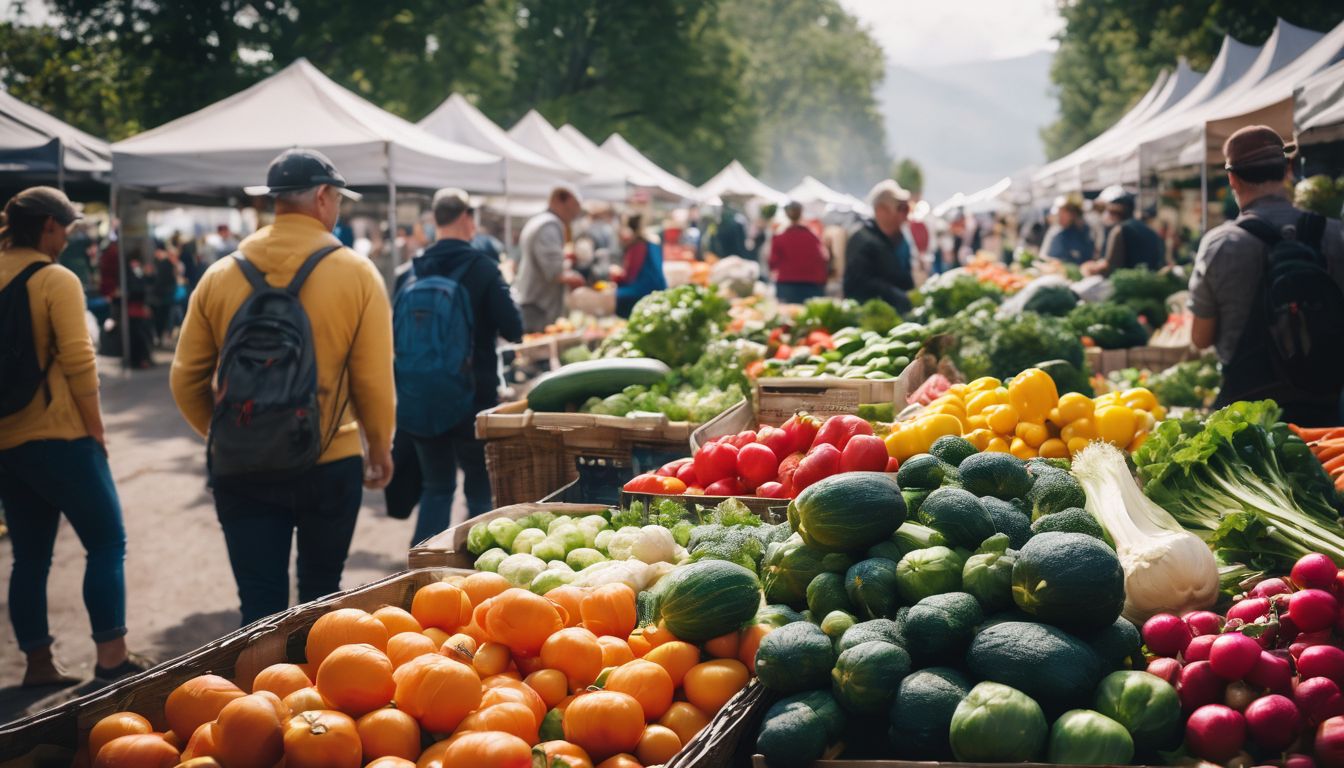In a world awash with refuse, many of us are on the hunt for methods to tread more lightly upon the earth. It’s a familiar scene – wrestling with the unease that comes from our consumerist lifestyles.
However, it may surprise you to learn that upwards of 90% of discarded materials can be given a new lease on life through upcycling. Allow our blog to serve as your compass in navigating the inventive realm of upcycled goods, and witness how they’re revolutionising our approach to shopping.
Prepare yourself to embrace an evolved concept of eco-conscious living!
Key Takeaways
- Upcycling transforms discarded materials into higher – value products, reducing waste and conserving resources. It has become a key sustainable practice in fashion and other industries.
- The history of upcycling can be traced back to the 1940s, gaining prominence in the 1970s with increased environmental awareness. Today, it is widely recognised by top fashion publications like Vogue as an impactful trend.
- Renowned designers and brands are turning to upcycled materials for creating unique fashion items and accessories. Sustainable menswear brands have showcased this at events like London Fashion Week.
- The food industry is also adopting upcycling techniques to repurpose by – products or surplus foods, contributing to reduced waste and promoting a circular economy mindset among consumers.
- Intellectual property rights play an essential role in protecting the creativity behind upcycled products, encouraging innovation while ensuring ethical business practices within the industry.
The Concept of Upcycling
Upcycling refers to the process of taking discarded or unused materials and creatively transforming them into new products with a higher value. This eco-friendly practice not only reduces waste but also promotes sustainable consumption and environmental conservation.
Definition
Upcycled products give discarded materials a second chance at utility and style, transforming them into something of higher quality or value than the original. We see this creative process as a form of artistic expression and environmental sustainability.
It’s not just about making do; it’s about innovating and reimagining what we already have. By breathing new life into previously used items, we support circular fashion and contribute to sustainable consumption that benefits our planet.
By choosing upcycled fashion products or repurposed items, we champion ecofriendly clothing and step away from the traditional throw-away culture. Our actions become part of a larger movement towards ethical fashion, one that prioritises green products over waste creation.
Now let’s explore why upcycling is gaining momentum over conventional recycling methods in our quest for a greener future.
Benefits of upcycling over traditional recycling
Upcycling reduces the amount of waste sent to landfills.
- Upcycled products often have a higher value and are more desirable due to their unique and creative designs.
- Upcycling promotes creativity, innovation, and resourcefulness by giving new life to discarded items.
- It requires less energy and resources compared to traditional recycling processes, contributing to reduced carbon footprint.
The Evolution and History of Upcycling
From the 1940s to present day, upcycling has become a popular trend in the fashion industry with notable examples of designers creating stunning pieces from repurposed materials. This evolution has also extended into other industries such as food, where upcycling is being used to address global food waste.
From the 1940s to present day
Upcycling has a rich history that dates back to the 1940s when it emerged as a creative response to material scarcity during wartime. Inventive individuals repurposed and transformed everyday items out of necessity, setting the stage for the modern upcycling movement.
- During the 1970s, upcycling gained momentum with the growing environmental awareness, leading to innovative approaches in various industries such as fashion, home decor, and art.
- In recent years, upcycling has evolved into a mainstream sustainable practice embraced by renowned designers and brands in response to global waste concerns.
- Today, upcycling continues to inspire eco – friendly solutions across diverse sectors, offering promising potential in addressing environmental challenges and promoting conscious consumerism.
Examples of notable upcycling in the fashion industry
The fashion industry has seen remarkable upcycling initiatives, with brands using discarded materials to create new and innovative designs. For instance, a renowned sustainable fashion brand has been repurposing old denim jeans into stylish jackets and bags, effectively reducing textile waste.
Another inspiring example is the use of reclaimed materials like vintage silk scarves to craft sophisticated dresses, giving them a second life while preserving precious resources.
In addition, some creative designers are incorporating recycled plastic bottles into their collections, transforming waste into eco-friendly clothing. Furthermore, luxury labels have embraced upcycling by upcycling surplus fabrics from previous collections to produce exclusive limited-edition pieces, promoting sustainability in high-end fashion.
The Rise of Upcycling
Vogue has recognised upcycling as a top trend for 2021, and sustainable menswear brands have been leading the way at London Fashion Week. Additionally, the food industry is also embracing upcycling as a way to reduce waste and create innovative products.
Vogue’s recognition of upcycling as a top trend for 2021
Vogue acknowledged upcycling as a top trend for 2021, highlighting its growing significance in the fashion industry. This recognition reflects an increasing consumer demand for sustainable and environmentally friendly products, prompting brands to embrace innovative approaches to manufacturing.
Upcycled products are gaining traction, offering consumers stylish options while contributing positively to environmental conservation and reducing waste.
Brands at the forefront of this movement are reimagining materials that would have otherwise been discarded or considered waste. By incorporating upcycled materials into their designs, these brands are not only minimising their environmental impact but also setting new standards for sustainability within the fashion industry.
Sustainable menswear brands leading the way at London Fashion Week
Sustainable menswear brands are taking centre stage at London Fashion Week, setting a new standard for environmentally friendly fashion. These innovative brands are prioritising the use of recycled materials and upcycled fabrics, creating zero waste fashion that resonates with eco-conscious consumers.
Embracing the upcycling trend, these forward-thinking labels not only promote sustainable products but also inspire a shift towards repurposed clothing in the industry.
At London Fashion Week, sustainable menswear brands showcase their commitment to producing ecofriendly items without compromising style or quality. By incorporating recycled goods into their designs, they contribute to the movement towards green fashion and encourage greater adoption of sustainable shopping practices.
Upcycling in the food industry
Upcycling in the food industry involves repurposing by-products or surplus food that would otherwise go to waste. This process offers a sustainable solution to reduce food waste and minimise environmental impact.
Through upcycling, various products such as fruit peels, vegetable scraps, and surplus grains can be transformed into nutritious snacks, ingredients for cooking, or even natural fertilisers for agriculture.
Furthermore, upcycled food products contribute to addressing global food waste issues by utilising resources efficiently and reducing the amount of organic material ending up in landfills.
Opportunities and Challenges for Brands
Brands have the opportunity to address global food waste through upcycling, but they also face challenges in gaining consumer acceptance and navigating intellectual property issues.
The role of brands in driving the upcycling movement is pivotal for creating a more sustainable future.
Addressing global food waste
To address global food waste, we can:
- Support initiatives that redistribute surplus food to those in need. This helps reduce waste and alleviate hunger simultaneously.
- Advocate for policies that encourage supermarkets and restaurants to donate unsold but edible food rather than disposing of it. This promotes sustainability and compassion.
- Embrace creative cooking methods that make use of food scraps or ingredients that are often overlooked, reducing the amount of food sent to landfill.
- Educate ourselves and others about the impact of food waste on the environment and explore ways to minimise our individual contributions.
- Encourage community involvement in composting organic waste, which enriches soil health and reduces methane emissions from landfills.
The consumer perspective
As environmentally conscious individuals, we play a crucial role in driving the demand for upcycled products. By choosing to support brands that utilise upcycling, we contribute to the reduction of waste and conservation of environmental resources.
Our purchasing decisions have the power to encourage more companies to adopt sustainable practices, ultimately leading to a positive impact on the environment.
Furthermore, by embracing upcycled products, we become part of a movement towards responsible consumerism. Through our choices, we send a clear message to businesses and industries about the importance of sustainability.
Let’s continue making informed decisions that promote conservation and environmental protection.
The role of intellectual property
Intellectual property plays a crucial role in the rise of upcycling, safeguarding the creativity and innovation behind new upcycled products. Brands can protect their unique designs, processes, and branding through patents, trademarks, and copyrights.
This encourages continuous development and investment in sustainable practices by providing legal protection against imitation or unauthorised use. By securing intellectual property rights, brands can confidently lead with innovative upcycled solutions that benefit both the environment and consumers.
Furthermore, respecting intellectual property rights fosters a culture of fair competition within the upcycling industry. It motivates brands to uphold ethical standards while promoting healthy market dynamics that drive further advancements in environmentally friendly production methods.
Conclusion
In conclusion, the rise of upcycled products demonstrates a growing trend towards sustainable and eco-friendly practices. Brands are seizing opportunities to address global food waste and meet the demands of environmentally conscious consumers.
The evolution and history of upcycling have paved the way for innovative approaches in fashion, food, and beyond, signifying a positive shift towards more mindful consumption. As we continue to embrace this movement, we can look forward to a future where upcycling plays a pivotal role in shaping a more sustainable world.
FAQs
1. What does the rise of upcycled products mean?
The rise of upcycled products refers to more people and companies taking old or unused items and turning them into new, useful products.
2. Why are upcycled products becoming popular?
Upcycled products are gaining popularity because they help reduce waste, save resources, and offer unique items that are often handmade and environmentally friendly.
3. Can any item be turned into an upcycled product?
Almost any item can be given a new life as an upcycled product with creativity – from clothing to furniture to art pieces.
4. Are upcycled products good for the environment?
Yes, by repurposing materials that would otherwise end up in landfills, upcycling reduces waste and conserves natural resources which is great for our planet.





